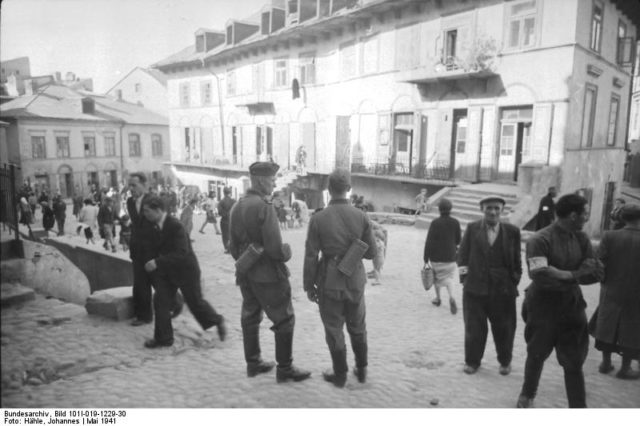The notorious 36th Waffen Grenadier Divison of the SS earned its appalling reputation mostly on the Eastern Front where they freely conducted numerous war crimes against civilians. They were encouraged to do so by the state, notably by Adolf Hitler himself. He intended to form a band of criminals as he believed their willingness to break the law was an act of unconventional courage which would undoubtedly come in handy during wartime.
The unit was formed primarily from former poachers on June 14, 1940, in the German town of Oranienburg. Hitler’s plan involved the assimilation of poachers into the Waffen SS so they could use their excellent hunting and tracking skills on guerrilla groups in the occupied territories. It was the beginning of his amnesty campaign to utilize prisoners for the war effort.
The group needed a strong leader. Oskar Dirlewanger, considered by many historians as a psychopath and the most perverted and violent Nazi officer ever, was given the job.
Dirlewanger was a convicted criminal with a reputation as a violent alcoholic and a sadist. He had been a member of the NSDAP but was expelled and imprisoned in 1934 for raping a 14-year-old girl, stealing a car and crashing it while driving drunk. After serving a two-year sentence, he was released but was soon after imprisoned again for sexual assault.
Dirlewanger was sent to a concentration camp, but through the help of a former WWI colleague who knew SS Chief Heinrich Himmler, he was once again released. Dirlewanger volunteered to serve on Franco’s side in the Spanish Civil War, where he was a member of the German Condor Legion from 1936-39. At the start of WWII Dirlewanger volunteered for the Waffen-SS and received the rank of Obersturmfuhrer (Senior Storm Leader).

For Hitler, Dirlewanger was the perfect leader. Mad, sadistic, and cruel, he proved to be pure evil. Some SS officials vigorously protested against the use of criminals in warfare – but not for ethical reasons. They considered the SS to be an elite formation that should not be involved with mere murderers, thieves, and rapists.
They were silenced when Dirlewanger was sent to Poland with his unit of 55 specially trained poachers to hunt down members of the Polish resistance. Their company was joined by three SS NCOs with a similar criminal record and 30 recruits. At first, they were called Oranienburg Poacher’s Unit, but as they had been appointed “under” SS control instead of being “part” of the SS, the unit was dubbed the Special Unit Dirlewanger.

In Poland, the unit grew to 300 men. The original idea of poachers hunting partisans was unofficially abandoned as the ranks were filled with criminals accused of premeditated manslaughter and the criminally insane. The decision was controversial from the start, but no one could argue with Hitler who, through Himmler, supported the atrocities of the Dirlewanger Unit. Some Nazi ideologists justified the use of these criminals, as they represented the “pure primitive German men” who were “resisting the law” in a rather Nietzschean fashion.
The company became notorious in Poland for their guard duties in the Lublin Ghetto in 1940. Various reports stated that during this period rape, murder, extortion, beatings and other crimes methods were employed by the members of the Special Dirlewanger Unit. The police chief of the Lublin Ghetto, Friedrich Wilhelm Krüger, was so appalled by the conduct of throat-cutting madmen that he appealed several times for them to be stopped. Instead, he was transferred to Belarus. So were the Dirlewangers, after their “work” in Poland was done.
Hitler used the unit to intimidate and prevent resistance, rather than fight it after it was already formed. As the Dirlewangers followed the war to the east, their ranks were filled with Ukrainian and Russian fascists such as Bronislav Kaminski and his Russian National Liberation Army who volunteered to serve under Nazi command. The Dirlwangers were essentially a penal unit, but they differed significantly from other so-called Straffbattalions for they were all men accused of severe crimes who were encouraged by the state to continue their rampage, free of all charges. Their methods in Belarus included rounding up entire villages in churches or large barns which were lit on fire. Machine guns were posted in front of these buildings in case anyone would manage to escape the burning structures.
By 1943, the Special Unit Dirlewanger was already a regiment and was involved in fighting with the Red Army. They had more and more casualties, as the men weren’t actually fighters, but butchers who were only used to killing unarmed civilians. They were undisciplined and lacked any sense of authority, often acting on their own.

When the Warsaw Uprising started on August 1, 1944, Dirlewanger and his regiment was sent alongside with Kaminski and his troops to “pacify” the insurgency. They were given a green light by Himmler to butcher, loot and rape as much as they could, and so they did. The unit was solely responsible for the Wola Massacre in Warsaw which included 500 small children.
The description of this slaughter was given by a Belgian sapper, Mathias Schenk, who witnessed Dirlewanger order his men to execute the children in the Wola district daycare with bayonets and rifle butts. Up to 40,000 civilians were murdered in Wola in less than two weeks of August, including all hospital patients and staff who were slaughtered in the most brutal and sadistic ways.
Nevertheless, Dirlewanger, who was an incapable officer, lost 2,733 men, which was more than two-thirds of the troops under his command.
After Poland, the Dirlewanger’s Unit was renewed and numbered 4,000 soldiers. They were sent to break the Slovakian Uprising in 1944, where they once again showed their brutality.
The same scenario, but to a lesser extent happened in Hungary where this penal unit was sent to fight the Socialist Partisans.

The unit transformed into a Waffen SS division in 1945, during Hitler’s last stand in Germany. After some fighting, Dirlewanger was captured by the Free French Forces in Germany and was allegedly murdered by his prison guards who were of Polish ethnicity. It is hard to determine the death count of the Dirlewangers which includes a span between 30,000 and 120,000 civilians in Belarus with more than 200 villages burned to the ground.
Their victims in Poland numbered approximately 50,000. The atrocities of the Dirlewanger unit were best depicted in Elem Klimov’s 1985 film titled Come and See which brutally depicts Nazi crimes in Belarus during the war.
